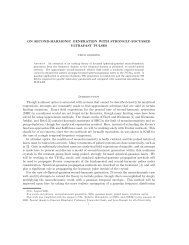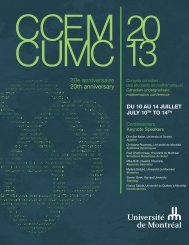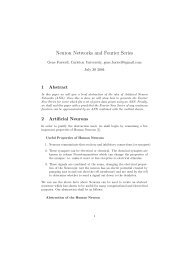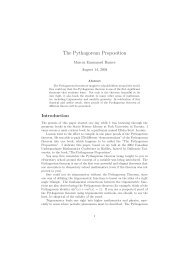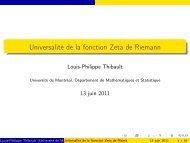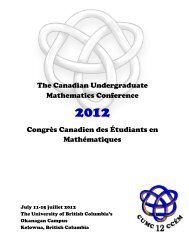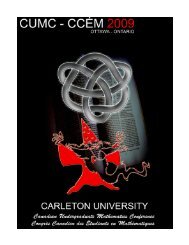booklet - CUMC - Canadian Mathematical Society
booklet - CUMC - Canadian Mathematical Society
booklet - CUMC - Canadian Mathematical Society
You also want an ePaper? Increase the reach of your titles
YUMPU automatically turns print PDFs into web optimized ePapers that Google loves.
MAGIC SQUARES AND ELLIPTIC CURVESJOANIE MARTINEAUElliptic curves have become very popular recently, mainly because of Andrew Wilesand his creative use of them in his proof of Fermat Last Theorem. Many mathematiciansfind them beautiful and interesting, including myself. In this talk, I will introduceelliptic curves and some of their properties. However, based on the title of this talk,you may be wondering what the link is between elliptic curves and magic squares... Iguess you will have to attend this talk to find out!Required Background: Basic group theoryA SCHUR-LIKE BASIS OF NSYM DEFINED BY A PIERI RULEJOHN CAMPBELLWe introduce a new basis, the “shin basis”, of the algebra of non-commutative symmetricfunctions using a right-Pieri rule. We prove that the commutative image of anelement of this new basis indexed by a partition equals the element of the Schur basis ofSym indexed by the same partition. A general identity involving the shin basis and theribbon basis is used to evaluate elements of the shin basis indexed by hooks in termsof the complete homogeneous basis. We prove a formula for elements of the shin basisindexed by reverse hooks using a sign-reversing involution. The results given in thistalk were proved in the course of an undergraduate summer research project at YorkUniversity.Required Background: Basic combinatorics.PROBLEM WITH THE FUZZY OPERATORJONATHAN GODINConvolution can be an elusive concept. During this talk, I will present the problemI’ve been working on concerning the convolution product equipped to sequence spaces.It should be accessible to everyone.Required Background: Basic analysis concepts.BELL’S THEOREM : NON-LOCALITY IN NATUREJORDAN PAYETTELoosely speaking, locality is the principle according to which any physical phenomenoncan not depend on events occuring arbitrary far away. While it has beendiscussed for centuries, locality only became an unavoidable element of the theoreticalframework of physics with the advent of the relativistic theories. That is why theproof given by John Bell in 1964 that quantum mechanics, the theory describing the fundamentalbehavior of matter, is irreproducible by any local (hidden-variable) theoriescame as a shock.In this presentation, I will present a simple proof of this theorem, based on theKochen-Specker theorem. It consists essentially in a simple problem about coloring aparticular graph. I will then give a brief introduction to the main ideas of quantum32



